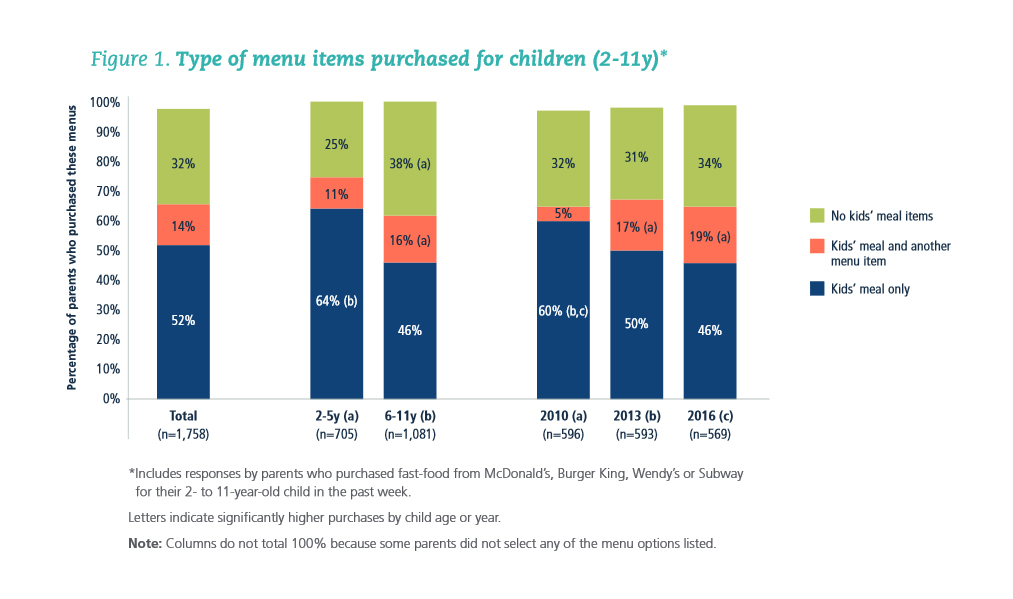
Share On Social!
Latino and all parents are purchasing fast food for their children more frequently in recent years, while 75% of kids meals still come with an unhealthy drink or side, according to a recent study by the UCONN Rudd Center for Food and Obesity.
Fast-food consumption is linked to poor diet quality in youth.
The new study examined parents’ reported fast-food purchases for their children ages 2-11 and changes over time, in light of several fast-food restaurants recently adopting policies to offer healthier drinks and/or sides with their kids’ meals.
Parents were surveyed in 2010, 2013, and 2016 about fast-food purchases at McDonald’s, Burger King, Wendy’s, or Subway. The 2016 survey also covered KFC, Dairy Queen, and Panera Bread.
The findings are unsettling.
Findings: More Fast Food Visits
In 2016, 91% of parents reported purchasing lunch or dinner for their child in the past week at one of the four largest fast-food restaurant chains, a significant increase compared to both 2010 (79%) and 2013 (83%), according to the study led by Dr. Jennifer L. Harris of the UCONN Rudd Center.
Latino parents (89%) especially reported purchasing food for their child in the past week from at least one of the four restaurants.
That was more than White (85%) and Black (84%) parents.
Parents have positive attitudes about healthier kid’s meal policies, with 3 out of 4 parents reporting that they would frequent a fast-food restaurant more often because of its healthier kids meal policies.
Findings: Still Too Many Unhealthy Options
 Several of the largest fast-food restaurants have introduced policies to offer healthier drinks and/or sides with their kids’ meals.
Several of the largest fast-food restaurants have introduced policies to offer healthier drinks and/or sides with their kids’ meals.
For example, McDonald’s, Wendy’s, Dairy Queen, Burger King, IHOP and Applebee’s voluntarily removed sugary drinks from kid’s menus.
But the new study found there has not been an increase of purchases of healthier drink and side items.
In fact, in 2016, 59% of parents who reported purchasing a kids’ meal at one of the four largest chains received a healthier kids’ meal drink (e.g., low-fat plain milk, 100% juice, plain water), nearly the same rate as in 2010.
 On top of this, most restaurants continue to have unhealthy main dishes, sides, and desserts on their kids’ menus. The researchers also found an increase in parents who purchased a kids’ meal plus another menu item, especially for an older child.
On top of this, most restaurants continue to have unhealthy main dishes, sides, and desserts on their kids’ menus. The researchers also found an increase in parents who purchased a kids’ meal plus another menu item, especially for an older child.
Still, there was one positive.
At Panera Bread, parents were most likely to purchase a kids’ meal (79%), and also most likely to purchase a healthier drink and healthier side (67% and 74%, respectively) with kids’ meals, compared to parents who visited other restaurants.
What Do These Findings Mean?
Together, these results suggest that parents are purchasing fast-food for their children more frequently than in past years, while the proportion of healthier drinks and sides received with kids’ meals has not improved, according to the study.
That is especially bad news for Latino families.
Latinos tend to live in food swamps, with limited access to healthy food options, according to a Salud America! research review. Also, 40% of Latino children are overweight or obese compared to 32% of all U.S. children.
The findings also indicate that restaurant policy changes in place are insufficient.
“It appears that restaurants’ voluntary policies as currently implemented are unlikely to substantially reduce children’s fast-food consumption overall, or increase their consumption of healthier items,” according to the study.
Those policies may actually backfire for public health.
They could “trick” parents into thinking they are choosing something healthy for their child without actually making healthier purchases.
“The positive attitudes expressed by parents about restaurants’ healthier kids’ meal policies suggest that such policies could lead to unintended public health consequences, such as an increase in the frequency of parents’ fast-food purchases for their children,” according to the study.
Push for Change
We must make healthy food selections at fast-food restaurants a requirement, not just an option among other unhealthy foods.
In areas of California, Colorado, Kentucky, and Maryland, laws and regulations are in place to require that all restaurants automatically provide healthy drinks and/or sides with kids’ meals.
Baltimore recently pushed sugary drinks off kid’s menus. A bill proposed in New York City aimed to make kids’ fast food meals more nutritious.
In San Antonio, a growing number of eateries have joined a city health program, ¡Por Vida!, that unites nutritionists with restaurants to promote healthier menu options.
“San Antonio and especially the West Side have a reputation of not having healthy foods and I want to change that by cooking delicious foods that also support a healthy life,” said Gilbert de Hoyos, who added healthy options to his Barrio Barista in San Antonio. “It’s my way of giving back to the community.”
By The Numbers
1
Supermarket
for every Latino neighborhood, compared to 3 for every non-Latino neighborhood



